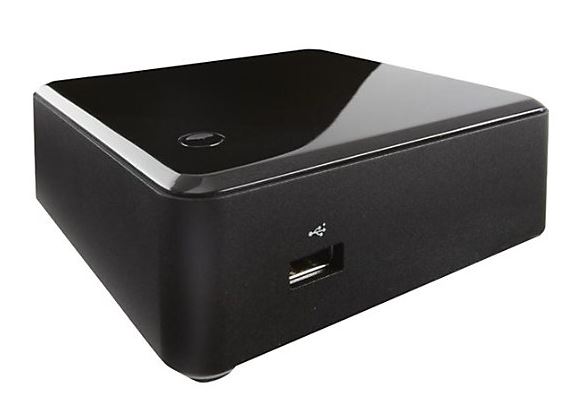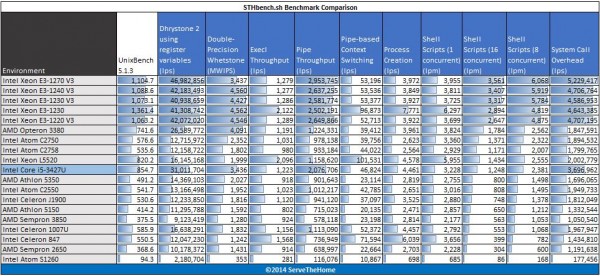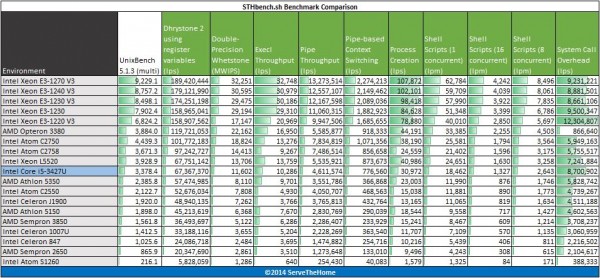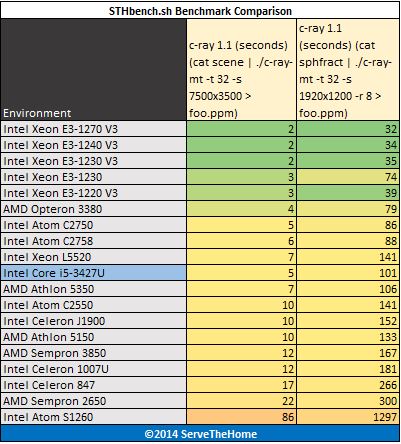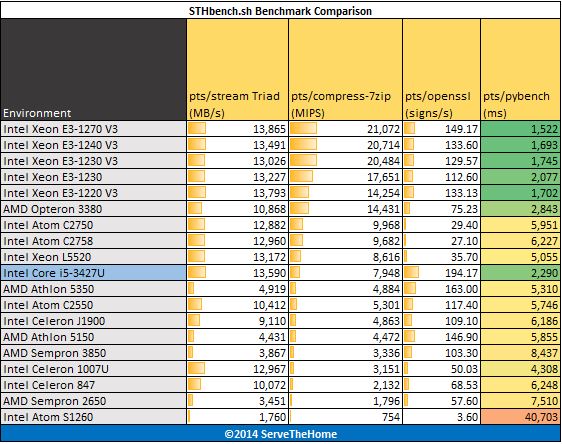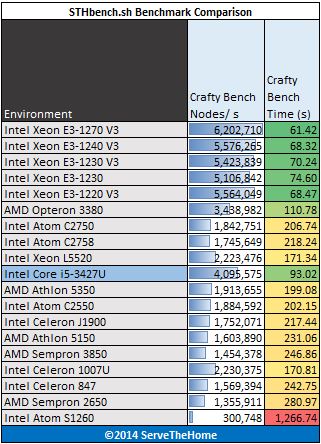Recently we have been testing many low cost, low power and low performance processors and just completed an April 2014 low power processor roundup with sub $100 processor + motherboard combinations. Several users responded that they were thinking of using the Intel DC53427HYE NUC for their virtualization or cloud labs. These Intel NUCs come with an embedded Intel Core i5-3427U processor which is a dual core part with hyper-threading and turbo boost. As a dual core part, this Core i5 gets 3MB of L3 cache. The base clock speed is 1.8GHz with a maximum Turbo boost of 2.8GHz. The CPU also supports VT-x, VT-d, AES-NI, vPro, Quick Sync and other features. It is also a 22nm 17w TDP so power consumption will be excellent.
Test Configuration
Given the NUC is a low power, low cost and integrated platform we did very little setup. We used components that would easily fit into the NUC chassis.
- Barebones Platform: Intel NUC DC53427HYE with Intel Core i5-3427U
- Memory: 2x 4GB Kingston DDR3L 1600MHz
- SSD: Crucial M500 120GB
- Power supply: Included with unit plus a 6 foot power cable
Overall, the NUC takes all of a minute or two to setup from a hardware perspective. It also makes mITX systems look gargantuan in comparison.
Intel Core i5-3427U Benchmarks
We are using our standard Linux benchmarking suite to get an idea about the Intel Core i5-3427U processor performance. As a direct result of user feedback, we recently had the benchmarks all put into a single script that you can use to benchmark your own systems. As development has progressed on the next version (which is almost ready for launch) we have moved the current script to STHbench 2013 – Download and Instructions as a resource on the forums. That guide has three simple commands that you can use with a stock installation to run our test suite and install/ compile all necessary files. No configuration is needed. For the next generation development version which currently can also run on CentOS and Mint, and expands the suite to include sysbench and redis-benchmark results, look here: (see Introducing the STHbench.sh Server Benchmarking Script).
The net goal is that we want others to be able to reproduce benchmarks and compare directly to their systems. Since we do not have access to every possible configuration, we would appreciate feedback in that thread which can be as simple as posting log files to run. Help is always appreciated!
Hardinfo Performance
hardinfo is a well known Linux benchmark that has been around for years. It tests a number of CPU performance aspects. One major advantage is that one can run this out of the box from many Ubuntu installations.
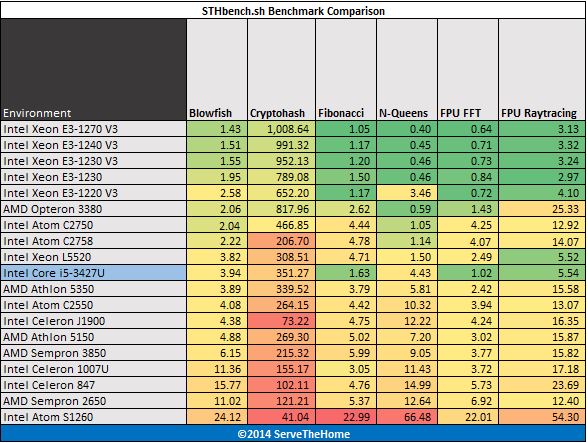
Here we see that the Intel Core i5-3427U is very competitive due to its Ivy Bridge architecture and ability to turbo boost. On the other hand, it is also significantly more expensive than many of the sub $100 motherboard and processor offerings.
UnixBench 5.1.3 Performance
UnixBench may be a defacto standard for Linux benchmarking these days. There are two main versions, one that tests single CPU performance on that tests multiple CPU performance. UnixBench segments these results. We run both sets of CPU tests. Here are the single threaded results:
The UnixBench single threaded CPU results show performance in-line with what we would expect from a single core turbo boost Ivy Bridge processors. The gap in many tests is about twice the single threaded performance of AM1 Kabini and Silvermont based architectures.
On the multi-threaded side, the Intel Core i5-3427U falls between the 4 core and 8 core Silvermont in terms of multi-threaded performance. Another interesting point is that the overall performance is just shy of the 4C/8T Xeon L5520 which was considered low power at the time. It does go to show how advancements over several generations of architectures do help performance in a given power envelope.
c-ray 1.1 Performance
c-ray is a very interesting ray tracing benchmark. It provides both consistent results and some clear separation. Ray tracing is generally a great multi-threaded CPU benchmark. For this test we use both a simple 7500×3500 render and a more complex 1920×1200 render. Here are the results: Our c-ray benchmark shows some fairly solid performance using c-ray’s rendering benchmark.
Our c-ray test tends to be very sensitive to architecture and threads. We see performance close to the Atom C2750.
Phoronix Test Suite Performance
We are using four tests from the Phoronix Test Suite: pts/stream, pts/compress-7zip, pts/openssl and pts/pybench.
- STREAM by John D. McCalpin, Ph.D. is a very well known memory benchmark benchmark.
- 7-zip compression benchmarks were a mainstay in our Windows suite so we are including it again on the Linux side as a compression benchmark.
- The pts/openssl benchmark is very dependent on the CPU architecture being used
- Python is a widely used scripting language and pyBench is a nice single-threaded Python benchmark
Here one can see that in terms of memory performance, the dual channel memory controller is working as expected. The other major call-out here is that the pybench does seem to be impacted most by architecture and clock speed. Even with additional cores, the Silvermont and Kabini AM1 chips struggle compared to Haswell and Ivy Bridge.
Crafty Chess Performance
Crafty is a well known chess benchmark. It is also one where we saw issues last time with the Phoronix Test Suite and running on ARM CPUs. We are planning to retire this benchmark in the 2014 version of STHbench. Here are the Crafty Chess results from simply running “crafty bench”:
Our crafty chess benchmark is a single threaded workload. As a result, the Core i5-3427U performs well in benchmarks where it can turbo boost.
A word on power consumption
For the sake of comparison with recent low power server/ workstation reviews, we did take a few power consumption measurements.
- Idle power consumption: 14.8w
- Maximum power consumption during benchmarks: 28.2w
Overall acceptable power consumption figures, but the 32nm process is starting to show its limitations.
Conclusion
Overall, the Intel Core i5-3427U performed acceptably for a $360 near silent unit. It can also drive HD monitors and become a portable workstation very easily. With many of the advanced features we would want to see from a lab processor, the Core i5-3427U the question is whether it is worth the cost. Compared to the lower cost options, the big question is diskless or with a disk. For diskless units, if one simply wants some network booting OpenStack nodes, then maybe the less expensive units make sense. For higher-end hypervisor nodes, the performance and feature sets one gets with a Core i5 system are tangible.
Feel free to suggest other low cost/ low power platforms in the forums and we will do our best to get to them. Another aspect of this is that we will be switching to STHbench2 soon which will have a revised set of tests that anyone can run on their own machines so new platform suggestions for seeding that data set are always welcome.

